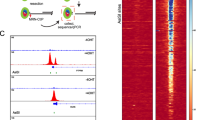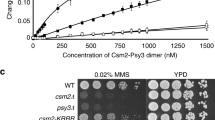Abstract
Using a defined substrate DNA with a single psoralen interstrand cross-link (ICL), we studied the molecular mechanism of human ICL repair. In vitro ICL repair by human extracts is dependent on replication and is a largely error-free process. Extracts from a human BRCA2-defective mutant cell line, CAPAN-1, are severely compromised in ICL repair. Specifically, 'unhooked' but not fully repaired products accumulate in the reaction with CAPAN-1, and transient expression of BRCA2 in CAPAN-1 restores repair activity. Together, these results reveal that BRCA2 participates in repair of replication-mediated double-strand breaks generated when replication forks encounter ICLs. We also show that nucleotide excision repair is essential for the removal of the lesion left behind on one strand after unhooking. This study provides new mechanistic insights into the repair of ICLs in human cells.
This is a preview of subscription content, access via your institution
Access options
Subscribe to this journal
Receive 12 print issues and online access
$189.00 per year
only $15.75 per issue
Buy this article
- Purchase on Springer Link
- Instant access to full article PDF
Prices may be subject to local taxes which are calculated during checkout



Similar content being viewed by others
References
Dronkert, M.L. & Kanaar, R. Repair of DNA interstrand cross-links. Mutat. Res. 486, 217–247 (2001).
McHugh, P.J., Spanswick, V.J. & Hartley, J.A. Repair of DNA interstrand crosslinks: molecular mechanisms and clinical relevance. Lancet Oncol. 2, 483–490 (2001).
Spanswick, V.J. et al. Repair of DNA interstrand crosslinks as a mechanism of clinical resistance to melphalan in multiple myeloma. Blood 100, 224–229 (2002).
Thompson, L.H. & Schild, D. Homologous recombinational repair of DNA ensures mammalian chromosome stability. Mutat. Res. 477, 131–153 (2001).
De Silva, I.U., McHugh, P.J., Clingen, P.H. & Hartley, J.A. Defining the roles of nucleotide excision repair and recombination in the repair of DNA interstrand cross-links in mammalian cells. Mol. Cell. Biol. 20, 7980–7990 (2000).
Kuraoka, I. et al. Repair of an interstrand DNA cross-link initiated by ERCC1-XPF repair/recombination nuclease. J. Biol. Chem. 275, 26632–26636 (2000).
Zhang, N., Lu, X., Zhang, X., Peterson, C.A. & Legerski, R.J. hMutSbeta is required for the recognition and uncoupling of psoralen interstrand cross-links in vitro. Mol. Cell. Biol. 22, 2388–2397 (2002).
Akkari, Y.M., Bateman, R.L., Reifsteck, C.A., Olson, S.B. & Grompe, M. DNA replication is required To elicit cellular responses to psoralen-induced DNA interstrand cross-links. Mol. Cell. Biol. 20, 8283–8289 (2000).
Bessho, T. Induction of DNA replication-mediated double strand breaks by psoralen DNA interstrand cross-links. J. Biol. Chem. 278, 5250–5254 (2003).
Rothfuss, A. & Grompe, M. Repair kinetics of genomic interstrand DNA cross-links: evidence for DNA double-strand break-dependent activation of the Fanconi anemia/BRCA pathway. Mol. Cell. Biol. 24, 123–134 (2004).
Niedernhofer, L.J. et al. The structure-specific endonuclease Ercc1-Xpf is required to resolve DNA interstrand cross-link-induced double-strand breaks. Mol. Cell. Biol. 24, 5776–5787 (2004).
Niedernhofer, L.J., Lalai, A.S. & Hoeijmakers, J.H. Fanconi anemia (cross)linked to DNA repair. Cell 123, 1191–1198 (2005).
Tavtigian, S.V. et al. The complete BRCA2 gene and mutations in chromosome 13q-linked kindreds. Nat. Genet. 12, 333–337 (1996).
Wooster, R. et al. Identification of the breast cancer susceptibility gene BRCA2. Nature 378, 789–792 (1995).
Brenneman, M. BRCA1 and BRCA2 in DNA repair and genome stability. DNA Damage and Repair Vol. 3 (eds. Nickoloff, J.A. & Hoekstra, M.F.) 237–267 (Humana Press, Totowa, New Jersey, USA, 2001).
Kraakman-van der Zwet, M. et al. Brca2 (XRCC11) deficiency results in radioresistant DNA synthesis and a higher frequency of spontaneous deletions. Mol. Cell. Biol. 22, 669–679 (2002).
Tutt, A. & Ashworth, A. The relationship between the roles of BRCA genes in DNA repair and cancer predisposition. Trends Mol. Med. 8, 571–576 (2002).
Venkitaraman, A.R. Functions of BRCA1 and BRCA2 in the biological response to DNA damage. J. Cell Sci. 114, 3591–3598 (2001).
Moynahan, M.E., Pierce, A.J. & Jasin, M. BRCA2 is required for homology-directed repair of chromosomal breaks. Mol. Cell 7, 263–272 (2001).
Xia, F. et al. Deficiency of human BRCA2 leads to impaired homologous recombination but maintains normal nonhomologous end joining. Proc. Natl. Acad. Sci. USA 98, 8644–8649 (2001).
Petukhova, G., Lee, E.-H. & Sung, P. DNA end-processing and heteroduplex DNA formation during recombinational repair of DNA double-strand breaks. DNA Damage and Repair Vol. 3 (eds. Nickoloff, J.A. & Hoekstra, M.F.) 125–146 (Humana Press, Totowa, New Jersey, USA, 2001).
Sung, P. Mediating repair. Nat. Struct. Mol. Biol. 12, 213–214 (2005).
West, S.C. Molecular views of recombination proteins and their control. Nat. Rev. Mol. Cell Biol. 4, 435–445 (2003).
Chen, P.L. et al. The BRC repeats in BRCA2 are critical for RAD51 binding and resistance to methyl methanesulfonate treatment. Proc. Natl. Acad. Sci. USA 95, 5287–5292 (1998).
Davies, A.A. et al. Role of BRCA2 in control of the RAD51 recombination and DNA repair protein. Mol. Cell 7, 273–282 (2001).
Galkin, V.E. et al. BRCA2 BRC motifs bind RAD51-DNA filaments. Proc. Natl. Acad. Sci. USA 102, 8537–8542 (2005).
Wong, A.K., Pero, R., Ormonde, P.A., Tavtigian, S.V. & Bartel, P.L. RAD51 interacts with the evolutionarily conserved BRC motifs in the human breast cancer susceptibility gene brca2. J. Biol. Chem. 272, 31941–31944 (1997).
Mizuta, R. et al. RAB22 and RAB163/mouse BRCA2: proteins that specifically interact with the RAD51 protein. Proc. Natl. Acad. Sci. USA 94, 6927–6932 (1997).
Sharan, S.K. et al. Embryonic lethality and radiation hypersensitivity mediated by Rad51 in mice lacking Brca2. Nature 386, 804–810 (1997).
San Filippo, J. et al. Recombination mediator and Rad51 targeting activities of a human BRCA2 polypeptide. J. Biol. Chem. 281, 11649–11657 (2006).
Yang, H., Li, Q., Fan, J., Holloman, W.K. & Pavletich, N.P. The BRCA2 homologue Brh2 nucleates RAD51 filament formation at a dsDNA-ssDNA junction. Nature 433, 653–657 (2005).
Cheng, S., Van Houten, B., Gamper, H.B., Sancar, A. & Hearst, J.E. Use of psoralen-modified oligonucleotides to trap three-stranded RecA-DNA complexes and repair of these cross-linked complexes by ABC excinuclease. J. Biol. Chem. 263, 15110–15117 (1988).
Van Houten, B., Gamper, H., Holbrook, S.R., Hearst, J.E. & Sancar, A. Action mechanism of ABC excision nuclease on a DNA substrate containing a psoralen crosslink at a defined position. Proc. Natl. Acad. Sci. USA 83, 8077–8081 (1986).
Goggins, M. et al. Germline BRCA2 gene mutations in patients with apparently sporadic pancreatic carcinomas. Cancer Res. 56, 5360–5364 (1996).
Connor, F. et al. Tumorigenesis and a DNA repair defect in mice with a truncating Brca2 mutation. Nat. Genet. 17, 423–430 (1997).
Morimatsu, M., Donoho, G. & Hasty, P. Cells deleted for Brca2 COOH terminus exhibit hypersensitivity to gamma-radiation and premature senescence. Cancer Res. 58, 3441–3447 (1998).
Yu, V.P. et al. Gross chromosomal rearrangements and genetic exchange between nonhomologous chromosomes following BRCA2 inactivation. Genes Dev. 14, 1400–1406 (2000).
van der Heijden, M.S. et al. In vivo therapeutic responses contingent on Fanconi anemia/BRCA2 status of the tumor. Clin. Cancer Res. 11, 7508–7515 (2005).
Lomonosov, M., Anand, S., Sangrithi, M., Davies, R. & Venkitaraman, A.R. Stabilization of stalled DNA replication forks by the BRCA2 breast cancer susceptibility protein. Genes Dev. 17, 3017–3022 (2003).
Cox, M.M. The nonmutagenic repair of broken replication forks via recombination. Mutat. Res. 510, 107–120 (2002).
Helleday, T. Pathways for mitotic homologous recombination in mammalian cells. Mutat. Res. 532, 103–115 (2003).
Johnson, R.D. & Jasin, M. Sister chromatid gene conversion is a prominent double-strand break repair pathway in mammalian cells. EMBO J. 19, 3398–3407 (2000).
Saleh-Gohari, N. & Helleday, T. Strand invasion involving short tract gene conversion is specifically suppressed in BRCA2-deficient hamster cells. Oncogene 23, 9136–9141 (2004).
Sonoda, E. et al. Sister chromatid exchanges are mediated by homologous recombination in vertebrate cells. Mol. Cell. Biol. 19, 5166–5169 (1999).
Stark, J.M., Pierce, A.J., Oh, J., Pastink, A. & Jasin, M. Genetic steps of mammalian homologous repair with distinct mutagenic consequences. Mol. Cell. Biol. 24, 9305–9316 (2004).
Arnaudeau, C., Lundin, C. & Helleday, T. DNA double-strand breaks associated with replication forks are predominantly repaired by homologous recombination involving an exchange mechanism in mammalian cells. J. Mol. Biol. 307, 1235–1245 (2001).
Hatanaka, A. et al. Similar effects of Brca2 truncation and Rad51 paralog deficiency on immunoglobulin V gene diversification in DT40 cells support an early role for Rad51 paralogs in homologous recombination. Mol. Cell. Biol. 25, 1124–1134 (2005).
Takata, M. et al. Chromosome instability and defective recombinational repair in knockout mutants of the five Rad51 paralogs. Mol. Cell. Biol. 21, 2858–2866 (2001).
Mu, D. et al. DNA interstrand cross-links induce futile repair synthesis in mammalian cell extracts. Mol. Cell. Biol. 20, 2446–2454 (2000).
Durocher, Y., Perret, S. & Kamen, A. High-level and high-throughput recombinant protein production by transient transfection of suspension-growing human 293-EBNA1 cells. Nucleic Acids Res. 30, E9 (2002).
Acknowledgements
We thank J. Hearst for the psoralen-modified oligonucleotides, S. Powell (Washington University) for the HA-BRCA2 plasmid and J. Reardon, R. Lahue, R. Lewis and A. Tomkinson for critical reading of the manuscript. This work was supported by grant CA095291 from the US National Institutes of Health and grant DAMD17-03-1-0225 from the US Army Medical Research and Materiel Command.
Author information
Authors and Affiliations
Corresponding author
Ethics declarations
Competing interests
The authors declare no competing financial interests.
Supplementary information
Supplementary Fig. 1
Defined substrate DNA used in the study (PDF 568 kb)
Supplementary Fig. 2
Control experiments for BRCA2-dependent, replication-coupled ICL repair (PDF 339 kb)
Rights and permissions
About this article
Cite this article
Cipak, L., Watanabe, N. & Bessho, T. The role of BRCA2 in replication-coupled DNA interstrand cross-link repair in vitro. Nat Struct Mol Biol 13, 729–733 (2006). https://doi.org/10.1038/nsmb1120
Received:
Accepted:
Published:
Issue Date:
DOI: https://doi.org/10.1038/nsmb1120
This article is cited by
-
Effect of BRCA mutational status on survival outcome in advanced-stage high-grade serous ovarian cancer
Journal of Ovarian Research (2019)
-
The role of DNA repair in chronic lymphocytic leukemia pathogenesis and chemotherapy resistance
Current Oncology Reports (2007)



